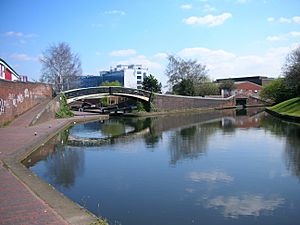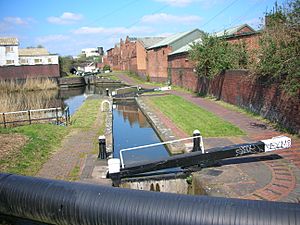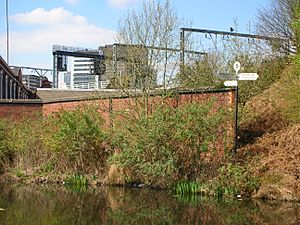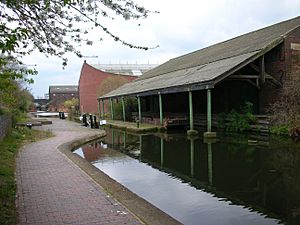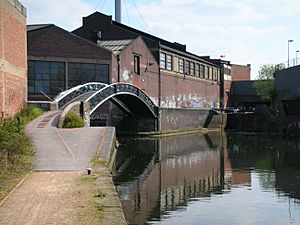Digbeth Branch Canal facts for kids
The Digbeth Branch Canal is a short but important canal in Birmingham, England. It connects two main canals: the Birmingham and Fazeley Canal at Aston Junction and the Grand Union Canal at Digbeth Junction. This junction is in an area of Birmingham called Digbeth.
This canal was finished in 1799. It was part of the Birmingham Canal Navigations network. Its main job was to create a path for boats between the Birmingham and Fazeley Canal and the Warwick and Birmingham Canal. The Warwick and Birmingham Canal is now part of the Grand Union Canal.
At first, boats had to move their goods across a small gap called the Warwick Bar. Later, a special lock was built there. This lock allowed boats to travel straight through without unloading.
The Digbeth Branch Canal is about 1¼ miles (2 kilometers) long. It has six locks that lower boats by 40 feet (12 meters) from Aston Junction. The last lock will be near the new High Speed 2 train station, Birmingham Curzon Street railway station.
After this last lock, the canal goes through a tunnel. This tunnel is a Grade II listed building, meaning it's an important historical structure. It carries railway lines over the canal. Beyond the tunnel is Digbeth Junction. From this junction, a short side branch leads to the Typhoo Basin.
Today, Digbeth Junction is often seen as where the canal meets the Grand Union Canal. But historically, the route went a little further. It passed under an old railway bridge to meet the Grand Union Canal at the Warwick Bar stop lock. This lock is behind the Birmingham Proof House. From here, the Grand Union Canal continues towards Bordesley Junction.
Most of the canal, from Ashted Lock to Great Barr Street, is part of the Warwick Bar Conservation Area. This means the area is protected for its historical importance.
Key Places Along the Canal
The Digbeth Branch Canal has several important points along its route. These include junctions, locks, and tunnels. They help boats navigate the canal and connect to other waterways.
- Aston Junction: This is where the Digbeth Branch Canal begins. It connects to the Birmingham and Fazeley Canal.
- Ashted Lock: One of the six locks that lower the canal's water level.
- Ashted Tunnel: A historic tunnel that carries railway lines over the canal. It has a north and south entrance.
- Railway Viaduct: An old bridge structure that crosses over the canal.
- Proof House Junction: A key meeting point for different canal sections.
- Warwick Bar: This historic spot was once a gap between canals. Now it has a stop lock.
- River Rea: The canal crosses near this river.
- Great Barr Street: A road that crosses over the canal.
- Bordesley Junction: Where the Grand Union Canal continues its journey.


